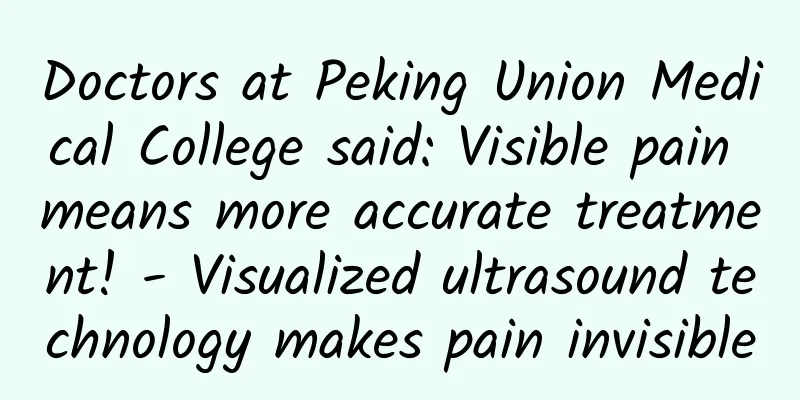Doctors at Peking Union Medical College said: Visible pain means more accurate treatment! - Visualized ultrasound technology makes pain invisible

|
Author: Cui Xulei, deputy chief physician of Peking Union Medical College Hospital Reviewer: Shen Le, Chief Physician, Peking Union Medical College Hospital There are more than 300 million people suffering from chronic pain in my country, and the number of new patients is between 10 million and 20 million each year. Chronic pain includes long-term neck and shoulder pain, back and leg pain, postherpetic neuralgia, and even cancer-related pain and muscle and soft tissue pain, which will cause great pain and inconvenience to patients. In recent years, a new treatment method called "visualized ultrasound diagnosis and treatment technology" has emerged. This technology helps doctors to treat more accurately through the precise guidance of ultrasonic imaging, thereby effectively alleviating patients' pain symptoms and improving their quality of life. Today, let the doctors of Union Hospital introduce to you the method of using visual ultrasound technology to treat chronic pain! 1. What is visual ultrasound technology? Visual ultrasound technology is a medical tool that uses ultrasound to generate real-time images. It generates images of the body's internal structures by emitting high-frequency sound waves into the human body and capturing the returning sound wave signals. This allows doctors to see clear images on the screen, helping them to accurately diagnose diseases and guide treatment. In recent years, this technology has been widely used in the field of pain treatment. With the real-time guidance of ultrasound, doctors can perform visual operations, making treatment more precise and effectively reducing the risk of complications. Not only that, ultrasound technology can also help doctors diagnose pain problems and is known as the doctor's "third eye." 2. How is visual ultrasound technology used in the diagnosis and treatment of chronic pain? Visual ultrasound technology is a non-invasive examination method that can display images in real time to help doctors accurately locate the location of pain. For example, this technology can be used to check muscle, ligament, nerve and bone problems to help doctors better formulate treatment plans; at the same time, it can also guide doctors to treat joints, nerves and soft tissues, such as injecting drugs into joints and performing nerve treatments. 3. What types of pain can be diagnosed using visual ultrasound technology? (1) Pain caused by injuries and strains of muscles, joints and ligaments: Ultrasound technology can help doctors check whether the structure and function of the patient's muscles, joints and ligaments are normal. For example, muscle strain, joint effusion, aging of spinal facet joints and other problems can be clearly shown on ultrasound images, thus helping doctors find the cause. In addition, for common muscle strains, elastic ultrasound examinations can show the differences in morphology and elasticity between strained muscles and healthy muscles, which can assist doctors in making diagnoses and evaluating treatment effects. (2) Pain caused by nerve damage: Ultrasound can assess whether the patient's nerves are compressed. For example, for patients with numbness or pain in the hands, ultrasound can check whether the nerves innervating the hands are compressed or swollen, thereby determining the cause of the numbness or pain in the hands, determining the specific location affected, and helping doctors determine the focus of treatment. (3) Pain caused by vascular disease: Ultrasound technology can be used to observe vascular structure and blood flow. For example, arterial stenosis or thrombosis can cause limb pain (i.e., ischemic pain). Figure 1 Copyright image, no permission to reprint 4. What types of pain can be treated with visual ultrasound technology? Most interventional treatments for pain can be performed under real-time ultrasound guidance, as follows. (1) Nerve block analgesia: By injecting anesthetics or steroids into specific areas, the nerves are blocked from transmitting pain signals. This method is commonly used for local nerve blocks, epidural blocks, and spinal nerve blocks. It can be used to treat a variety of pain, such as cervicogenic headaches, postoperative pain, lumbar neuralgia, and postherpetic neuralgia. (2) Pulsed radiofrequency or radiofrequency thermocoagulation: Under ultrasound guidance, a thin needle (radiofrequency needle) is inserted into the area that needs treatment. By releasing electrical pulses to stimulate the target nerves, the current and conductive substances in the nerves are regulated, so that the patient feels numbness in the painful area, thereby relieving the pain. During radiofrequency thermocoagulation, the heat generated by high-frequency current is used to destroy the nerve or tissue function that causes pain, thereby relieving pain. It can be used to treat postherpetic neuralgia, diabetic neuropathy, and trigeminal neuralgia. (3) Spinal cord stimulation: Under ultrasound guidance, electrodes or catheters are implanted around the spinal cord to give the spinal cord a certain amount of electrical stimulation to relieve pain. This method is suitable for difficult-to-treat neuralgia and complex local pain. (4) Intrathecal morphine pump: Under ultrasound guidance, a special pump tube is implanted into the space between the brain and spinal cord (subarachnoid space) to continuously deliver morphine or provide electrical stimulation to relieve pain. This method is suitable for pain caused by cancer and chronic pain that is difficult to control. In addition, there are other treatment methods, such as acupotomy, endothermic needle and platelet-rich plasma therapy, which can also be performed under ultrasound guidance. 5.What are the advantages of visual ultrasound-guided interventional treatment? Compared with traditional blind puncture guidance, visualized ultrasound technology has the following two main advantages. (1) Real-time visibility: Visual ultrasound technology can provide instant images, allowing doctors to observe the internal conditions of the treatment area in real time during the treatment process. During puncture treatment, doctors can see the position of the puncture needle and its relationship with the target point and surrounding tissues (such as blood vessels, organs, etc.) throughout the process, and adjust the puncture direction at any time as needed. Compared with traditional methods, this method is more accurate in positioning and safer in operation. (2) No radiation hazard: Visual ultrasound technology does not use radiation and will not cause radiation damage to the human body. This means that during the treatment process, the patient does not need to be exposed to radiation multiple times. For patients with chronic pain who require long-term, multiple treatments, this method is safer, more practical, and has a wider range of applications. Figure 2 Copyright image, no permission to reprint 6.What are the precautions when using visual ultrasound diagnosis and treatment technology? Although visual ultrasound technology has many advantages in treating chronic pain, it also has some limitations. For example, ultrasound waves have difficulty passing through bones, so this method may not be accurate enough when dealing with some complex bone problems, and sometimes it needs to be combined with other imaging technologies to assist in diagnosis. In addition, doctors who use visual ultrasound technology for treatment need to receive professional training and have extensive experience to ensure the accuracy and safety of treatment. |
<<: Although seafood is delicious, you need to be careful when eating it
>>: [Medical Q&A] How to prevent psoriatic arthritis?
Recommend
What foods are good for women to eat to protect their ovaries
When hearing the word "ovary", I believ...
Two months pregnant, a lot of vaginal discharge
Even during pregnancy, a woman's ovaries will...
Can I get pregnant during the safe period?
Generally, pregnancy will not occur during the sa...
Treatment for delayed menstruation
Nowadays, many young people do not pay attention ...
Is it okay to wear seamless bras if you have small breasts?
Many people have very small breasts. When the bre...
Dermatomyositis: Uncovering the mysterious dialogue between skin and muscle
Dermatomyositis, a seemingly strange and mysterio...
Coughing and abdominal pain in early pregnancy
In the early stages of pregnancy, pregnant women ...
What does a company background check check? When is a company background check usually conducted?
I believe that when you are looking for a job, yo...
What if it is an ectopic pregnancy?
Anyone who has done their homework seriously know...
Girls' rebellious teenage years
In life, many girls will develop some rebellious ...
Can women with immature uterus have IVF?
Although there are people who advocate singleness...
What is the cause of chest tightness and pain during menopause?
When a woman enters menopause, she should adjust ...
What should women do if they have dark eye bags?
Women pay the most attention to their external im...
Menstruation has not come for several days and the color is brown
Menstruation is a barometer of a woman's phys...
Vulvar leukoplakia pictures and symptoms
Vulvar leukoplakia usually causes the substantial...









